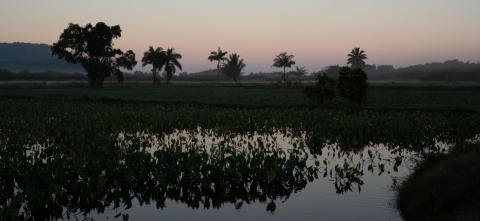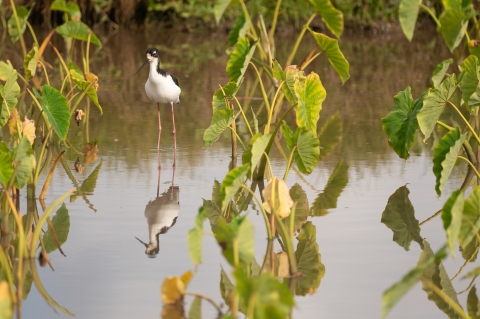What We Do
The U.S. Fish & Wildlife Service manages Hanalei National Wildlife Refuge to:
- Protect and enhance Hawaiian waterbird populations and provide high quality nesting and feeding habitat.
- Protect and enhance the native plant community and riverine ecosystem.
- Provide opportunities for wildlife observation, interpretation, and environmental education.
Providing Undisturbed Habitat
In accordance with the mission of the U.S. Fish and Wildlife Service, one of our most important management functions is protecting wildlife by providing undisturbed habitat. We accomplish this goal by:
- Promoting the conservation of endangered species, especially endangered koloa maoli (Hawaiian duck, Anas wyvilliana), ae‘o (Hawaiian stilt, Himantopus mexicanus) ʻalae ʻula (Hawaiian gallinule, Gallinula chloropus sandvicensis), and ‘alae ke‘oke‘o (Hawaiian coot, Fulica alai) through healthy functioning of wetland floodplains.
- Optimizing water levels for maximum habitat size and value for endangered, resident, and migrating waterbirds while reducing the growth and reproduction of invasive species invasive species
An invasive species is any plant or animal that has spread or been introduced into a new area where they are, or could, cause harm to the environment, economy, or human, animal, or plant health. Their unwelcome presence can destroy ecosystems and cost millions of dollars.
Learn more about invasive species . - Constructing impoundments, building islands, controlling water levels, disking, tilling, spraying herbicide, and farming taro.
- Expanding understanding, appreciation, and stewardship of the wetland and coastal ecosystems through wildlife-oriented educational opportunities.
- Developing cross-programmatic and community partnerships to enhance wetland and watershed habitats.
Management and Conservation
Hanalei Valley Viewpoint Project - Final Environmental Assessment
The U.S. Fish and Wildlife Service has published the Hanalei Valley Viewpoint at Hanalei National Wildlife Refuge Final Environmental Assessment (EA) and Finding of No Significant Impact. The viewpoint project will provide the community with increased opportunities for interpretation and access to Hanalei National Wildlife Refuge.
“We are excited to be working with the community and our partners to implement the Hanalei Valley Viewpoint project," said Kauai National Wildlife Refuge Complex Project Leader Heather Abbey Tonneson. “We hope the site will provide a place for both locals and visitors to enjoy the Hanalei National Wildlife Refuge, native wildlife, and important information about the Hanalei Valley and North Shore.”
Wetland Management and Waterbird Conservation Plan and Environmental Assessment
Our Wetland Management and Waterbird Conservation Plan and Environmental Assessment for Hanalei National Wildlife Refuge was released for public in 2020. Through the planning process, we looked at ways to improve Refuge habitat for priority listed species; fill knowledge gaps through targeted monitoring and research; and improve current farming practices and relations to ensure a more sustainable holistic approach which benefits the listed birds on the Refuge.
The focus of the plan was to fulfill the Refuge purpose by providing quality habitat that meets the life-history requirements of these species.
Traditional Hawaiian Agriculture and Wetlands Management
Kalo (taro) has been farmed in the Hanalei River Valley for over 1000 years. In modern times, various other agriculture crops (rice, coffee, mulberry and more) were attempted but resulted in little long-term success. Kalo cultivation, however, continues to endure. This crop is culturally important, provides important economic benefit to the community, and provides valuable habitat for native Hawaiian as well as migratory waterbirds.
Kalo is grown in flooded patches, similar to rice paddies. The crop takes about 9 months to mature. During the various stages of growth, the kalo lo’i provides foraging and nesting habitat for waterbirds as well as a place to hide from predators.
In conjunction with Service managed wetlands. Kalo farming is managed through a special use permit and renewed annually.





